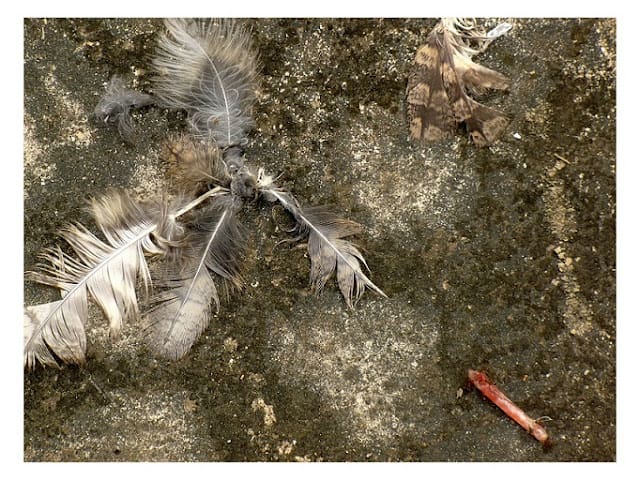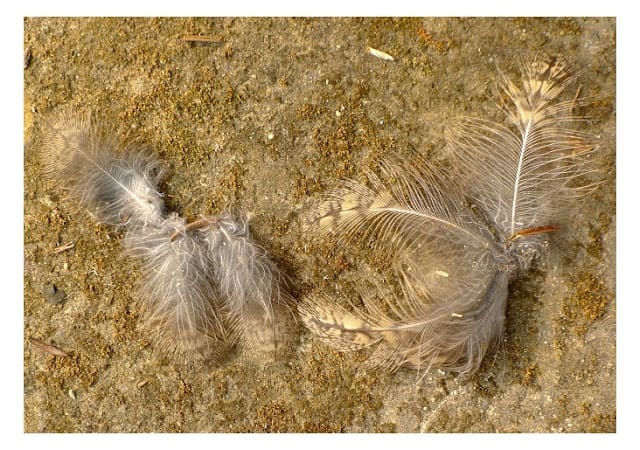 |
| Silent in life — and in death |
While critiquing a book by his contemporary Stephen Jay Gould, the noted writer on evolutionary theory Richard Dawkins refutes his contention that the idea of progress in evolutionary history of life is an artifact of our anthropocentric bias, and evolution is an inherently random process that tracks the changes in environment. Dawkins responds with the saw-toothed model and suggests that while over very large spans of time we may not find any progressive trends, in a shorter time-span the predator-prey arms race might lead to progressive building up and refinement of technology, an upward movement on a progressive ramp.
It took a bird’s death for me to understand this. I had spent a full week in November last year enthralled by my first sighting of the Large-tailed Nightjar (Caprimulgus macrurus). Its perfect camouflage, the absolute silence, the soft noiseless flight, the lovely liquid eye — all spoke of the careful honing by evolution: A perfect night bird. I missed it unless I knew it was there. Sometimes, I could not locate it even when I knew it might be there. So often, I missed it even while peering through binoculars. My admiration for the bird peaked with every passing day and every sighting. All the time I tramped along the garden looking but not sighting it just added to my veneration of the nightjar. I was in no doubt that its adaptation to its tropical habitat was perfect.
Natural selection is described by many as an elimination process. Since it weeds out the unfit, it involves reduction. But we usually do not realize that it can be an enormously creative process as well. Any improvement in the weaponry of the predator’s tactics (viz. running speed, capacity for camouflage) is tracked by the prey (better warning calls, speed, etc.) and vice-versa. Such mirrored improvements lead to positive feedback and often go into a vicious spiral. Ernst Mayr describes such an arms race between marine snails and snail-eating crabs. The snails, he wrote, protected themselves against snail-eating crabs by “evolving stronger shells as well as all sorts of structural elaborations of the shell” and made it harder for the crabs to crush them with their pincers. He added: “The crabs, in turn, develop stronger claws, which induce the snails to grow tougher shells…” (Ernst Mayr, What Evolution Is, Basic Books 2001, Pg 210-211).
Turns out the bird’s adaptation, though excellent, wasn’t perfect. On the last day, just before the vacations ended, I visited the local temple. I have been fascinated by the lichens that grow on the temple’s crumbling plaster. On the platform were strewn a few feathers, most of a pigeon-sized bird but shaded in gray, buff and brown. My heart skipped a beat. “Nightjar!” the feathers cried out. I could think of no other bird with these lovely soft shades evolved to merge with the tropical soil and leaf litter. Whoever or whatever had killed the bird had probably pounced on it on the ground and brought it up to the temple’s platform to finish it off. A predator plotting its evolutionary curve, honing the technology to kill to survive. In this case, seeking out silent, well-camouflaged ground birds.
Arms races lead to progress in the short and medium term (in terms of geological time) since they usually come to an end either due to the extinction of one party (in which case the other party might hit a plateau or even regress) or due to economic reasons. Sometimes, both parties may go extinct due to a natural catastrophe and then the arms race will begin anew among the lineages of their successors. Moreover, since undue diversion of limited resources (e.g. continuous improvement in running speed) eventually starts to hurt somewhere else, sooner or later, the attribute (running speed) will plateau off. Further improvement will come only at the cost of other investments that are necessary for survival, e.g. making extra milk for cubs. Moreover, there are physical limits to improvements in animal technology, e.g. the ability to execute high jumps or improve dive time (hold breath).
I never saw the predator but guessed it was the local Jungle Cat (Felis chaus) that once littered in the hollow of a large dead mango tree nearby. I can imagine it, in the fashion of Ted Hughes’ The Thought Fox – another perfectly camouflaged mammal, its mottled grey brown coat merging with the night, stepping softly and soundlessly, silent hot breath, an approach from the rear to hide the shining all-seeing eyes, a tense crouch and then the leap. As nightjars get better in their camouflage, the jungle cat too gets better at seeking it out, locked as they are in the eternal fight for survival, the predator and prey inching up the incline of the saw-tooth.
The arms race does not lead to progress in the global sense since it is punctuated by extinctions, plateaus and sometimes by regress. However, in the short phase that these races happen, they are progressive. Dawkins writes: “Only a saw-tooth succession of small progresses terminated by extinctions. Nonetheless, the ramp phase of each saw-tooth was properly and significantly progressive.” (Pg 214).
Death really does help us see things more clearly.
Dawkins signs off by saying, “If you let the animals bring their own definition you will find progress, in a genuinely interesting sense of the word, nearly everywhere.” No anthropocentric bias but races along the saw-tooth incline spiraling to extinctions.
No wonder Dawkins is called the high-priest of Neo-Darwinism.
Text and photographs by Sahastrarashmi
- Encounter: The Sacred Grove at Oorani - November 28, 2012
- Encounter: Rhododendron, sentinel of the highlands - October 7, 2012
- Manjhi Akshayavat, an immortal Banyan tree - July 17, 2012









